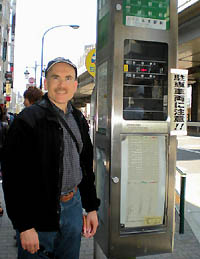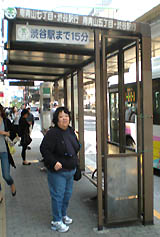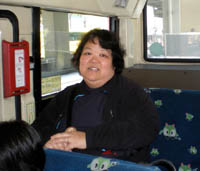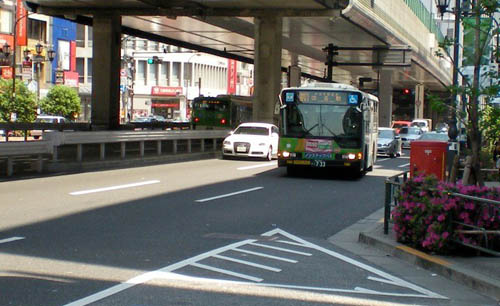


The sign shows how soon the bus will come.
June 8 - One reason Ann and I enjoy living in Tokyo is the city's excellent public transportation system. Most of our friends living in the United States cannot believe that we do not own a car, but we do not feel the need.


Ann's sittin' in the back.
Tokyo's trains and subways are fast, efficient, safe, clean, and inexpensive. Our Pasmo card is good on trains, subways, streetcars, and the buses so we do not need to worry about buying tickets or carrying change with us. Although some trains and subways may be crowded during rush hour, it is remarkable how well the region's transportation system works considering the enormous number of persons the system moves.
Although we frequently take these forms of transportation, Ann and I prefer to take the bus on weekends. One reason is that we enjoy looking out the window and seeing the pedestrians, shops, and signs that contribute to Tokyo's vibrant street culture. The new "Non-Step" buses are very easy to enter and exit. Another reason is that fellow passengers on the bus seem more friendly than when riding the train or subway. Somehow by sharing the same bus, we passengers must gain a feeling of neighborliness. For example, it is much more common to see young riders giving up their seats for an elderly passenger on the bus than on a train or subway. Also, since we enter at the front of the bus, we gain the chance to greet the driver in person. This helps build a more personal connection than with the unseen subway driver, who only communicates with us by intercom.

We particularly frequent the #1 bus, which travels from Shimbashi to Shibuya Station. This bus comes very frequently - about every 10 minutes. The sign at each bus stop is connected via radio to the buses so that a flashing sign indicates the distance to the closest approaching bus. What a convenient feature! On weekends when the weather is nice, we sometimes take the #1 bus east for shopping in the Ginza or to visit Hibiya Park. Other times we take the bus west to Shibuya. No matter which way we travel, I try to thank the driver as we disembark. Maneuvering such a large vehicle in Tokyo's busy traffic is not an easy job, but Ann and I appreciate that the city bus drivers seem to take such great pride in delivering us safely to our destination.
Until next time,
Jim
Bus service story is interesting and fun to read, which remind me of interstate bus services in the U.S. In Japan bus services are common and convenient, which runs through cities, but in the States interstate buses run long distance. I have seldom had a bus ride in Tokyo and usually take subway instead. I should try once.
Can you explain the new "One Step" buses? Is the step literal or figurative? (i.e. even people who have trouble walking can board easily; or is it one simple process to pay the fare and board?)
When this item was first posted I thought the bus was called "One Step," but I went back and checked and it's actually called a "Non-Step" bus. When you board a Non-Step bus, you only have to step from the curb onto the bus. Once you enter, there are no other stairs to navigate within the bus, as the floor of the bus is the same level as you enter. The only exception would be at the very rear of the bus where you would climb one step to get to the back row of seating. Many of the buses have adjustable shocks, so when it arrives at the stop, the bus actually "kneels down" to make it easier to board. Both of these features make it very easy to ride a bus in Tokyo!
- Jim